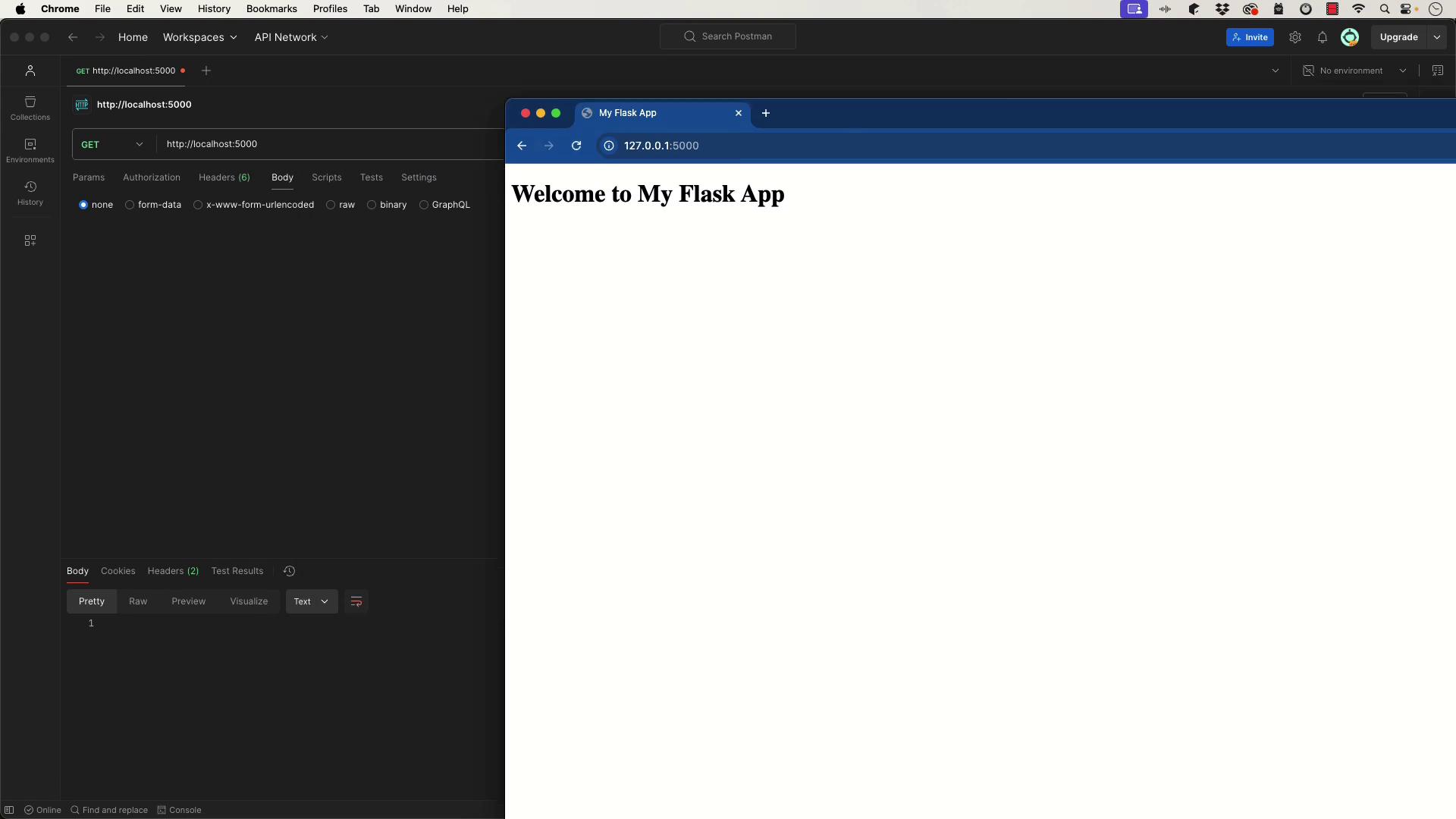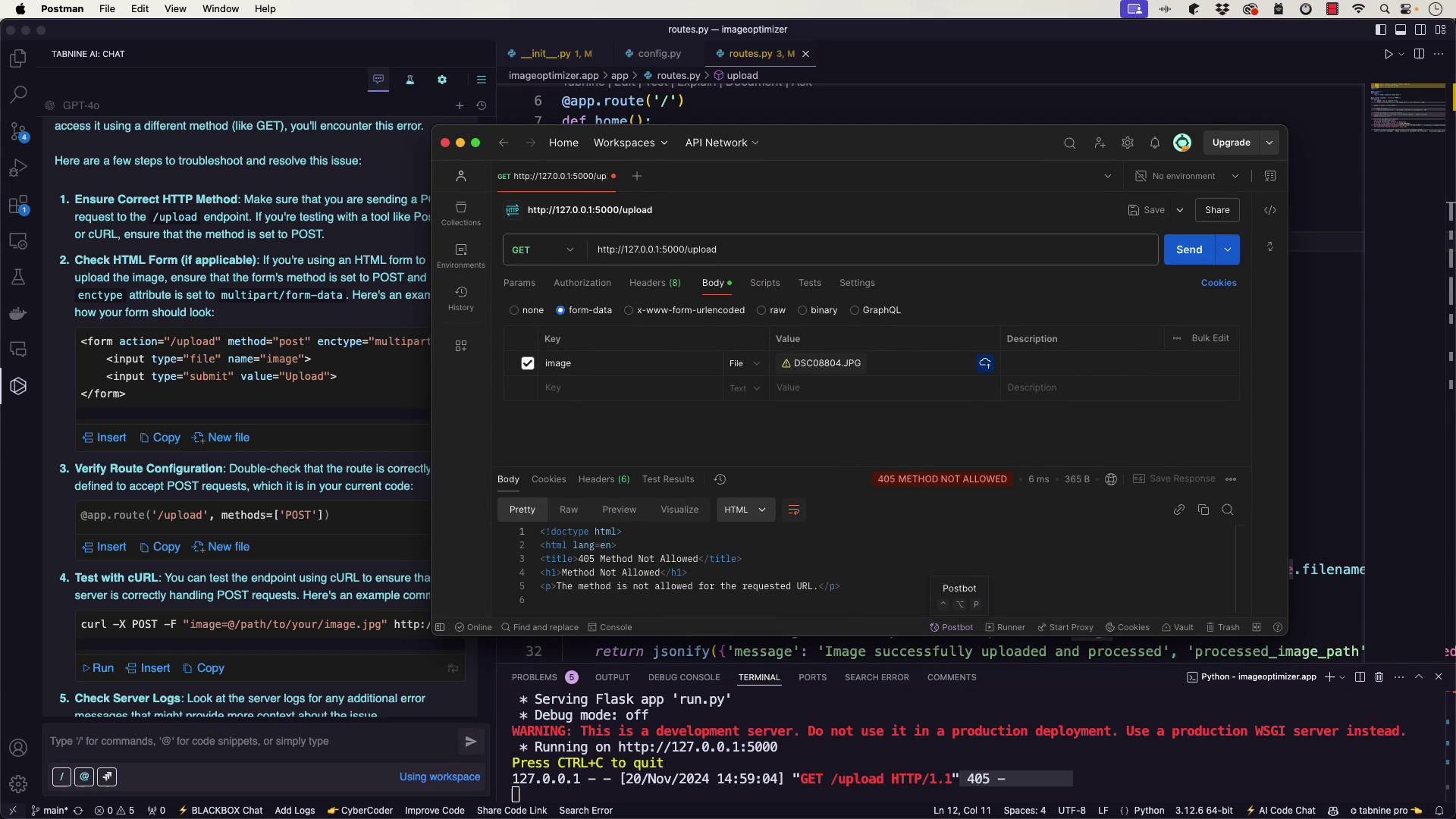AI-Assisted Development
Development Phase Backend
Implementing OpenCV
In this lesson, we demonstrate how to integrate OpenCV into a Flask application to handle image uploads and processing. The application features endpoints for rendering a basic webpage and for uploading and processing images. The functionality evolves from a simple image save to a robust system that converts images to grayscale, compresses them, and supports a dynamic quality parameter.
Basic Route Setup
Begin by defining basic routes in your Flask application. Initially, you set up a home route that renders the base HTML and a debug route to list all registered URL rules.
from flask import render_template
from flask import current_app as app # Use current_app for consistency
@app.route('/')
def home():
return render_template('base.html')
@app.route('/about')
def about():
return "About Page"
@app.route('/routes')
def show_routes():
output = []
for rule in app.url_map.iter_rules():
output.append(f"{rule.endpoint}: {rule.rule}")
return "<br>".join(output)
Later, the unused "about" page is removed to focus on image upload functionality.
Setting Up the Upload Route
Create an upload route that accepts an image via a POST request, saves it locally, and processes it using OpenCV. In this initial stage, the code accepts an image and saves it, returning a simple message.
from flask import request, render_template, current_app as app
@app.route('/')
def home():
return render_template('base.html')
@app.route('/upload', methods=['POST'])
def upload():
# Accept an image uploaded from a POST request
image = request.files['image']
# Save the image to a local directory
image.save(app.config['UPLOAD_FOLDER'] + '/' + image.filename)
# Return a simple success message
return "About Page"
This snippet serves as the starting point for enhancing the functionality.
Enhancing the Upload Functionality with OpenCV
Enhance the upload endpoint by adding error checking and utilizing OpenCV to process the image—converting it to grayscale in this example. The endpoint returns a JSON response containing a success message and the path of the processed image.
@app.route('/upload', methods=['POST'])
def upload():
if 'image' not in request.files:
return jsonify({'error': 'No image part in the request'}), 400
image = request.files['image']
if image.filename == '':
return jsonify({'error': 'No image selected for uploading'}), 400
# Save the image to a local directory
image_path = os.path.join(app.config['UPLOAD_FOLDER'], image.filename)
image.save(image_path)
# Process the image with OpenCV: convert to grayscale
img = cv2.imread(image_path)
gray_img = cv2.cvtColor(img, cv2.COLOR_BGR2GRAY)
processed_image_path = os.path.join(app.config['UPLOAD_FOLDER'], 'processed_' + image.filename)
cv2.imwrite(processed_image_path, gray_img)
# Return a JSON response with the path to the processed image
return jsonify({
'message': 'Image successfully uploaded and processed',
'processed_image_path': processed_image_path
}), 200
For reference, here is the version before AI-assisted enhancements:
@app.route('/upload', methods=['POST'])
def upload():
if 'image' not in request.files:
return jsonify({'error': 'No image part in the request'}), 400
image = request.files['image']
if image.filename == '':
return jsonify({'error': 'No image selected for uploading'}), 400
# Save the image to a local directory
image_path = os.path.join(app.config['UPLOAD_FOLDER'], image.filename)
image.save(image_path)
# Process the image with OpenCV
img = cv2.imread(image_path)
# Example processing: convert to grayscale
gray_img = cv2.cvtColor(img, cv2.COLOR_BGR2GRAY)
processed_image_path = os.path.join(app.config['UPLOAD_FOLDER'], 'processed_' + image.filename)
cv2.imwrite(processed_image_path, gray_img)
# Return a success message with the path to the processed image
return jsonify({
'message': 'Image successfully uploaded and processed',
'processed_image_path': processed_image_path
}), 200
Understanding these changes is critical for following the application’s evolution.
Running the Application and Installing OpenCV
Before running your application, install OpenCV via pip:
pip install opencv-python
Ensure your application configuration correctly sets the upload folder. For example, in your configuration file:
SECRET_KEY = 'your_secret_key'
app.config['UPLOAD_FOLDER'] = '/path/to/upload/folder'
After configuration, run your Flask application:
(venv) jeremy@Jeremys-Mac-Studio imageoptimizer.app % flask run
Note
If you encounter an error such as "No module named 'cv2'", make sure the OpenCV installation succeeded.
Testing the Upload Endpoint
After starting the Flask server, test the /upload endpoint using tools like Postman or cURL. In Postman, configure the request as follows:
- Method: POST
- URL: http://localhost:5000/upload
- Body: Form-data with the key "image" for the image file
The diagram below illustrates a Postman interface with a GET request to the base URL and a browser displaying the welcome message.

Upon a successful POST request, server logs will show a 200 response, and the processed image is saved locally.
Adding Image Compression and a Dynamic Quality Parameter
Further enhance the upload functionality to compress the image using a user-specified quality parameter. Users can pass a "quality" parameter through the POST form data to determine the JPEG compression level. The following code snippet reflects these updates:
@app.route('/upload', methods=['POST'])
def upload():
if 'image' not in request.files:
return jsonify({'error': 'No image part in the request'}), 400
image = request.files['image']
if image.filename == '':
return jsonify({'error': 'No image selected for uploading'}), 400
# Get the quality parameter from the request; default is 10 if not provided
quality = request.form.get('quality', default=10, type=int)
# Validate the quality parameter (must be between 0 and 100)
if quality < 0 or quality > 100:
return jsonify({'error': 'Quality must be between 0 and 100'}), 400
# Save the image to a local directory
image_path = os.path.join(app.config['UPLOAD_FOLDER'], image.filename)
image.save(image_path)
# Process the image with OpenCV: compress using the specified quality
img = cv2.imread(image_path)
processed_image_path = os.path.join(app.config['UPLOAD_FOLDER'], 'processed_' + image.filename)
cv2.imwrite(processed_image_path, img, [int(cv2.IMWRITE_JPEG_QUALITY), quality])
# Return a JSON response with the path to the processed image
return jsonify({
'message': 'Image successfully uploaded and processed',
'processed_image_path': processed_image_path
}), 200
Test this functionality using cURL with the following command:
curl -X POST -F "image=@/path/to/your/image.jpg" -F "quality=50" http://127.0.0.1:5000/upload
This Postman diagram below shows an example of a POST request being made. Ensure the request type is POST with form-data.

Make sure your requests use multipart/form-data and target the correct URL (http://localhost:5000/upload).
Troubleshooting and Final Remarks
Warning
If you encounter issues such as a 405 Method Not Allowed or a 404 Not Found error, please ensure:
- The Flask server is running correctly.
- The
/uploadroute is configured to accept POST requests. - Your requests include the correct form-data keys ("image" and optionally "quality").
This lesson covered how to:
- Define basic routes in a Flask application.
- Implement an image upload endpoint with error handling.
- Integrate OpenCV to process images (grayscale conversion and compression).
- Allow dynamic specification of JPEG compression quality via a POST parameter.
Happy coding!
Watch Video
Watch video content